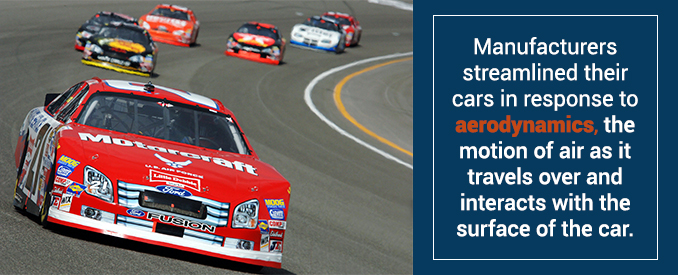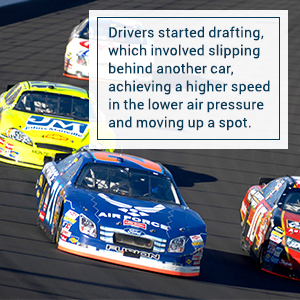Chapter 6: Factors Affecting Podium Positions
The outcome of a race is rarely, if ever, determined by the driver’s skill alone. Track conditions are in constant flux due to a myriad of forces putting more and more pressure on the vehicle, gradually degrading its performance.
It’s a delicate dynamic and one that requires a high degree of flexibility from all parties involved. At the end of the day, what can be guaranteed is that pit road will always come between the drivers and the finish line.
Aerodynamics
The cars that compete in NASCAR have been finely tuned and turned into precision racing machines over six decades and as many generations.
In the beginning, they were boxy Pontiacs, Fords, Dodges and Plymouths. As more manufacturers came to be aware of the importance of proper aerodynamics, they began looking at the ways they could streamline their production lines.

Essentially, the concept boils down to the motion of air as it travels over and interacts with the surface of a solid, moving object. When attempting to build a perfectly aerodynamic vehicle, teams must consider three principles: downforce, drag and skyward force — more commonly known as lift.
Downforce, Lift and Drag
As air pressure is applied from above, a bond between the car and the asphalt is created — the strength of which is dependent upon the amount of force pushing against all sides of the vehicle.
Car owners continually test the aerodynamics of their race cars to ensure the opposing force, or lift, is less than equal to the downforce, keeping the car in constant contact with the track. For this to be achieved, the nose of the vehicle must be lowered to reduce the airflow beneath the undercarriage.
Spoilers were implemented as a means of generating more downforce at the tail end of the cars — the area most susceptible to skyward force — and this had the effect of stabilizing any pressure imbalances.
However, the problem of wind resistance continued to frustrate NASCAR drivers. The lead car incurred the highest penalty because the drag required a premium in terms of horsepower and fuel-efficiency. Teams had to find a way around this.
Car Height and Handling
One of the things that manufacturers attempted to do when they first started experimenting with more optimal body types was reduce the car’s height and decrease the angle of the windshield so that it directed the air back and over the car.
These changes, while subtle, had a dramatic effect on drag. If drivers weren’t already engaging in slipstreaming, or “drafting,” they soon would be.
Drafting Strategies
The practice of slipping in behind a car to follow in their wake was a tactic that took advantage of lower air pressures, enabling the second vehicle to attain a higher speed and overtake the first. But success was not always a sure thing.
A skilled driver would be able to control and dictate the movements of the follow car more often than not, and maintain their position. If the tables were somehow turned, the driver who lost the lead could then employ the same strategy and wait for an opportune moment to pass.
It wasn’t long before the new style of racing became ubiquitous across the sport, creating a surge in popularity and delighting many fans in the U.S. and around the world.
Brake System Efficiency
With there being 43 cars on the oval at any one time, all putting out 750 horsepower and traveling at speeds of 150 mph for 500 miles straight, a lot of energy is transferred to the track. With 28 out of 31 circuits paved with asphalt, the heat is enough to change the way the road behaves.
Asphalt may not have a melting point, but the oils in its composition are prone to liquefying at temperatures north of 100 degrees Fahrenheit — a target that’s easily reached thanks to friction.
This principle is applied to the tires whenever a driver hits his brakes. The more brakes, the sooner they will need to be replaced. As a result, those who limit the use of the brake and clutch tend to end up on their final lap well ahead of those who don’t.
Suspension and Tire Traction
As the tires lose a little more of their tread, they also lose the ability to grip the asphalt, and the driver finds he has less control than he might otherwise like. In addition, the car’s suspension system may fail to adapt alongside these changes and further compromise the driver’s chance at placing.
If this happens, it’ll be up to the pit crew to perform a wedge adjustment and devote a few extra seconds to getting the suspension precisely right. More often than not, the calculated risk pays off.
Wedge Adjustments
Wedge adjustments are how pit crews can raise or lower the amount of tension acting on the springs in the rear suspension. Redistributing the weight of the car allows it to better absorb the adverse effects of bumps in the road.
In the rear window of each race car are three small holes — one left and two on the right — and they each serve a specific purpose. The left and forward right holes are for wedge adjustments, while the hole closest to the back on the right is reserved for track bar adjustments.
Track Bar Adjustments
Sharing some similarities with wedge adjustments, track bar adjustments locate the rear end of the vehicle from left to right. The responsibility of realigning the roll center of the car usually falls to one of the rear tire carriers, though it’s not uncommon for the gas man to also assume this role.
Interestingly, NASCAR decided to implement a change halfway through the 2015 season that would let drivers adjust their rear track bar from inside the cockpit, reducing their dependency on pit road and the pit crews stationed there.
Ultimately, the aim of a wedge or track bar adjustment is to return the car to its equilibrium by slotting a wrench through one of the holes and tuning the springs.
Table of Contents
- The Tools of a NASCAR Pit Crew
- Introduction
- Chapter 1: A Brief History of Pit Crew Racing
- Chapter 2: Structure of Race Car Pit Crews
- Chapter 3: Anatomy of the 12-Second Pit Stop
- Chapter 4: The Sports Science Behind NASCAR
- Chapter 5: Evolution of Tools and Racing Equipment
- Chapter 6: Factors Affecting Podium Positions
- Chapter 7: The Future of Pit Crews
- Conclusion: NASCAR as a National Phenomenon



